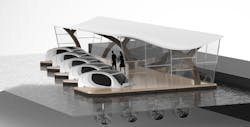Project Update: Bursting the Bubble of Regular Transit
SeaBubbles is an eco-friendly transportation system designed to alleviate congested streets. The Sea Bubbles are projected to be introduced to Paris to offer service on the River Seine in 2017.
"The Idea comes from my co-founder Alain Thebault," said Anders Bringdal co-founder and CEO of SeaBubbles. "With the Hydroptere sailing boat that he has developed for many years. This is the boat that is the start of the foiling generation in sailing. We used all the knowhow from this to add to the Seabubbles."
The water taxi, which float just above the water, feature an egg-shaped design and are battery operated. Each of the water taxis has the ability hold five people, at the time being with one person as a driver - but the SeaBubble's team is looking to make them driverless.
"First of all we like to look of the boat and this design came though. We believe it is super important that the look is right and liked for any product you come up with today," explained Bringdal. "Part from that the design in-cooperates a big study on the Center of Gravity point (CG) as well as taking in account the total Mass of the boat. Extra weight have a direct link with the distance you will get under battery power."
Alleviating congested streets
SeaBubbles would provide a method of transport that wouldn't be faced with issues like road traffic. The design makes the SeaBubbles rise above the water, rather than floating on the water like a boat.
"They are on foils that cut the water and leave no waves. They are silent and leave no pollution," explained Bringdal.
This means that depending on the size of the river that the SeaBubbles are traveling on, there could be multiple traveling at once while not disrupting each other. According to Bringdal the foils cut the water in place of pushing it.
Bringdal said, "the foils work in the water like a airplane wing does in the air. With speed 7 knots in our case the boat will lift out of the water until the foils come more and more out of the water. When the point have been reached where the foils are partly out of the water there is not enough foil in the water to lift anymore. At that stage the boat is stable and have found its natural height out of the water."
Utilizing new technology
The SeaBubbles are powered with lithium batteries, which makes them not only eco-friendly, but it also means that they emit no pollution or noise. The SeaBubble has propellers that will give approximately 240 kilos of thrust, while the foil wings underwater work to raise the bubble above the water. As a result of the way that it travels there is a 40% reduction in water resistance, which in turn, is designed to save battery power. The batteries have the ability to be charged up while being docked with solar panels as well as with the use of marine turbines, increasing their eco-friendly appeal. The water taxis are then able to run for approximately two hours, working off of a six to seven minute charging time.
For the batteries Bringdal said that he is working with different manufactures, they do not design their own batteries — but he said that they are looking for the best preforming product.
For the operation of the bubbles they are looking towards a popular technology that is being utilized in cars and drones. "We will have drivers for now, driverless in the future. Maybe driverless first in privet situations like developments around Lakes and so on. We've got to handle the legality of driver less first. But that being said I think it is easier to have driverless boats than cars, as there is less things to hit. Boats today operate well on autopilot so it is less a step to handle than what the cars need to do."
Crafting a new form of transit
Building a new method of transit is a process. The finalized design was set for testing in December 2016 and production will begin in 2017 — with a projected launch of June 2017.
"For now we are working on launch early summer in Paris. This is a test and show of the system. We will operate this test ourselves," said Bringdal. "We are looking for operators after this as if we stay as operators our self we will be slowed down in our goal of global launch. We have lots of demand from operators but need to go step by step at this point."
Funding their project through investors, Bringdal said that the upcoming weeks were important for the SeaBubbles team. "We are half way through (raising funding). These are an important two week for us now, as we may close with two bigger guys that may join us."
While SeaBubbles will first be seen in Paris, Bringdal said that they have had interest — and hope to expand elsewhere.
"I have demand from all over the place. Part from France we also got the U.S., Australia, New Zealand, Asia, India, the Middle East, Africa, Scandinavia and greater Europe," added Bringdal. "It is a bit overwhelming at the moment but I am very happy to see we have such demand. Cities are really looking for ways of public transport that is green and easy to implement. With little over 1 knot of current our system is automatic. Plug and play kind of thing. We generate the energy we need to operate."
The idea of taking the rising congestion out of rising populations in urban cities is a welcome one.
"From the start of the idea we today are starting to mold it into a good possible option to being stuck in traffic jam," said Bringdal. "In effect it is a tool that can be used joined with others to get some good fun transport around the world."


